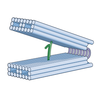The Biophysical and Biomedical Measurement Group engineers and fabricates custom chips, sensors, and nanostructures that enable measurements across scales from the biomolecular to cellular and tissue levels. These devices and systems provide the means to quantify dynamic biological phenomena of single molecules and molecular ensembles, cellular properties, cell-material and cell-cell interactions, tissue responses to drugs, and metabolic processes, as well as provide basic metrology for biomedical systems (pressure, flow, size, temperature, optical, electrical, and mechanical properties). Our projects and programs support innovation and commercialization of cell-based measurement tools (e.g., organ-on-chip and flow cytometry), cell-derived therapies (e.g., stem cell and CAR T cells), and biomonitoring/control systems (e.g., drug delivery). Moreover, they serve as a foundation for future growth in wearable and implantable devices (wireless communication, sensors, and flexible materials), as well as quantitative imaging and sensing, including linking chemical with physical information. We also develop fundamental measurement techniques and supporting theoretical frameworks for biological processes at the biomolecular level, such as conformational transitions during signaling, activation, and drug metabolism. Many of these techniques incorporate biological elements into nanoscale and microscale devices for high-sensitivity detection and characterization of analytes (biomolecules, drugs, metabolites, ions, and other molecular matter) and sequencing of nucleic acids and proteins. Overall, the Group aims to produce devices that allow biologists and biomedical researchers, in both basic and applied settings, access to advanced measurement methods and platforms that promote innovation in the future bioeconomy and improve quality of life.
News and Updates
Publications
Software
Awards
Press Coverage
Contacts
Group Leader
-
(301) 975-4258
Office Manager
-
(301) 975-2052












